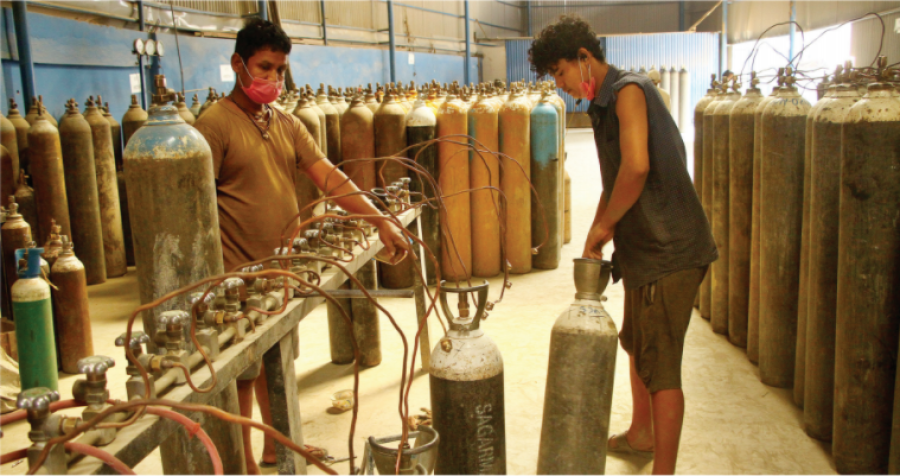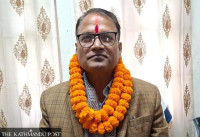National
Citing falling demand from hospitals, oxygen manufacturers seek to resume supply to factories
Health Ministry officials say they can’t give permission immediately as the pandemic has yet to come under control.
Prithvi Man Shrestha
Sagarmatha Oxygen Private Limited on Friday distributed around 70 cylinders of oxygen to a few glass factories even though the government is yet to formally lift the restriction on the distribution of oxygen for non-medical purposes.
In late April, amid surging Covid-19 cases, the government had instructed oxygen manufacturers to supply bottled oxygen only to hospitals while individuals could get oxygen based on the recommendation of hospitals.
But since late May, the number of daily Covid-19 cases started coming down, leading to a drop in demand for oxygen from hospitals. Also, increased oxygen plants and oxygen concentrators supplied to hospitals also reduced the demand for oxygen to be supplied by private sector suppliers.
“We distributed around 70 cylinders for 3 to 4 glass factories on Friday after they complained of disruption in manufacturing due to lack of oxygen,” Narayan Timilsina, chairperson of Sagarmatha Oxygen, said.
“As the demand for oxygen from hospitals has fallen and filled cylinders are lying in our factories, Health Ministry officials told us that we could resume a limited distribution for non-medical purposes.”
His factory produces enough oxygen to fill 850 to 900 cylinders a day. All of them would be supplied to hospitals when Covid-19 cases surged in May. “Currently, the demand from hospitals is for around 500 cylinders per day,” said Timilsina.
Oxygen manufacturers say they have lately been asking the government to officially allow them to resume supply to factories as the demand from hospitals is going down.
Besides falling Covid-19 cases, several hospitals have set up their own oxygen plants while oxygen concentrators have been supplied to many hospitals, hence the fall in demand. On Sunday, the country reported 1,694 new coronavirus cases, a sharp drop from 8,000 to 9,000 cases daily in early May.
According to Gaurav Sharda, president of Oxygen Industries Association of Nepal, they have asked the Health Ministry to allow resumption of oxygen supply for non-medical purposes amid falling demand from hospitals. “I am waiting for a government decision for resuming supply to factories,” said Sharda, who is also director of Kantipur Oxygen.
He has two plants in Kathmandu with a combined capacity to fill 800 cylinders per day and two more in Biratnagar with equal capacity.
“One small plant in Biratnagar with the capacity of filling 200 cylinders per day broke down two days ago and it remains closed,” he said. “I am also planning to close down the small plant in Kathmandu with 200 cylinders daily capacity if the demand continues to plunge.”
Even now, most of the Kathmandu-based oxygen plants are operating 24 hours a day, which according to Sharda is because operation cannot be halted and resumed instantly. “With hospitals and individuals not returning empty cylinders in time, it has been difficult for factories to operate 24 hours a day,” he said.
According to the Oxygen Industries Association, the eight Kathmandu-based oxygen plants had been supplying around 5,000 cylinders daily before the second wave of the pandemic hit the country despite having a combined daily capacity of 8,000 cylinders. About 70 percent of their output went to hospitals and the rest to factories and individual households, according to the association.
With the second wave of Covid-19 creating an oxygen crisis in the country, oxygen plants had struggled to cope with the demand. In late April, manufacturers stopped supplying oxygen to factories. Welding, grill and glass processing factories and hydropower projects are some of the major consumers of oxygen.
With daily infections falling close to 2,000 per day, demand for oxygen from hospitals has now come down significantly. However, government officials say they have not yet received any request from plants for resuming oxygen supply to factories.
“They may have made a request to the Covid-19 Crisis Management Centre or other government agencies but they have not come up to the Health Ministry with such a proposal,” said Dr Madan Upadhyay, the director of the Curative Service Division at the Department of Health Services. “Such a proposal has not been included in the list of demands they made such as incentives for existing oxygen factories and identifying misplaced oxygen cylinders.”
The government appears unwilling to allow oxygen plants to resume supply for non-medical purposes as the pandemic situation has yet to normalise.
“At the moment, we cannot say that the medical sector doesn't need extra oxygen as some oxygen factories have broken down and some others are undergoing maintenance,” said Upadhyay. “Considering that there are still a large number of Covid-19 patients needing supplemental oxygen, we have not thought about giving permission for the resumption of supply to the industrial sector.”




 12.12°C Kathmandu
12.12°C Kathmandu















